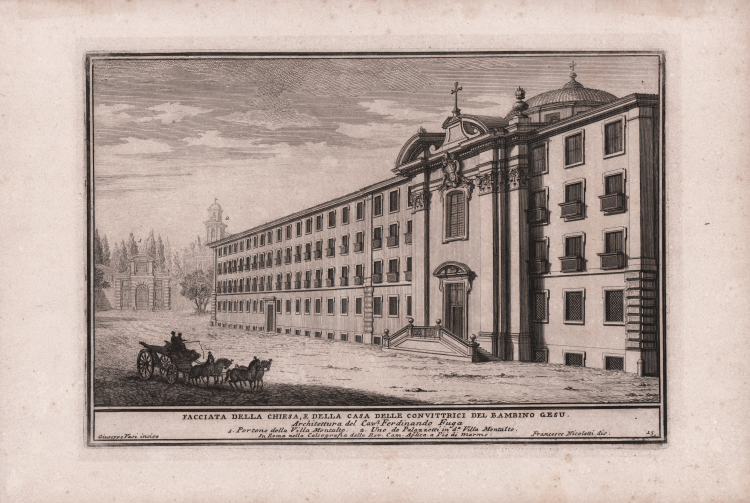



| Reference: | S3329 |
| Author | Giuseppe VASI |
| Year: | 1739 |
| Zone: | Chiesa del Bambin Gesù |
| Printed: | Rome |
| Measures: | 290 x 205 mm |


| Reference: | S3329 |
| Author | Giuseppe VASI |
| Year: | 1739 |
| Zone: | Chiesa del Bambin Gesù |
| Printed: | Rome |
| Measures: | 290 x 205 mm |
Veduta tratta da Il Secondo Libro Del Novo Teatro Delle Fabriche Et Edificj Fatte Fare In Roma Et Fvori Di Roma Dalla Santita' Di Nostro Signore Papa Clemente XII, stampato a Roma nel 1739 dalla Calcografia Camerale.
L’opera è il seguito de Il Primo Libro Del Nuovo Teatro Delli Palazzi di Alessandro Specchi, pubblicato nel 1699 dalla tipografia De Rossi.
Acquaforte, impressa su carta vergata coeva, con margini, in buono stato di conservazione.
Bibliografia
C.A. Petrucci, Catalogo Generale Delle Stampe Tratte Dai Rami Incisi Posseduti Dalla Calcografia Nazionale, 1412, p. 125, 1953.
Giuseppe VASI (Corleone, 27 Agosto 1710 - Roma, 16 Aprile 1782)
|
Italian engraver and painter. After completing a classical education, he trained as a printmaker in Palermo, possibly at the Collegio Carolino, which was founded by the Jesuit Order in 1728 and at which the etcher Francesco Ciché ( fl before 1707; d Palermo, 1742) was a teacher. Vasi was already an accomplished engraver when, in 1736, he contributed to the illustration of La reggia in trionfo by Pietro La Placa, which described the festivities held in Palermo to mark the coronation of Charles VII of Naples (the future Charles III of Spain). That same year Vasi moved to Rome, where, as a Neapolitan subject, he was immediately afforded the protection of the ambassador, Cardinal Troiano Aquaviva d’Aragona (1694–1747). In Rome he met other artists who worked for the same patron: Sebastiano Conca, Luigi Vanvitelli and Ferdinando Fuga. It is against this background that Vasi’s work in Rome, when he was in residence at the Palazzo Farnese, should be considered: his monopoly as the engraver of the Roman records of the monarch, the plates for the festivals of the ‘Chinea’ and the triumphal arches erected in front of the Palatine gardens on the occasion of temporal sovereignty over Rome
|
Giuseppe VASI (Corleone, 27 Agosto 1710 - Roma, 16 Aprile 1782)
|
Italian engraver and painter. After completing a classical education, he trained as a printmaker in Palermo, possibly at the Collegio Carolino, which was founded by the Jesuit Order in 1728 and at which the etcher Francesco Ciché ( fl before 1707; d Palermo, 1742) was a teacher. Vasi was already an accomplished engraver when, in 1736, he contributed to the illustration of La reggia in trionfo by Pietro La Placa, which described the festivities held in Palermo to mark the coronation of Charles VII of Naples (the future Charles III of Spain). That same year Vasi moved to Rome, where, as a Neapolitan subject, he was immediately afforded the protection of the ambassador, Cardinal Troiano Aquaviva d’Aragona (1694–1747). In Rome he met other artists who worked for the same patron: Sebastiano Conca, Luigi Vanvitelli and Ferdinando Fuga. It is against this background that Vasi’s work in Rome, when he was in residence at the Palazzo Farnese, should be considered: his monopoly as the engraver of the Roman records of the monarch, the plates for the festivals of the ‘Chinea’ and the triumphal arches erected in front of the Palatine gardens on the occasion of temporal sovereignty over Rome
|